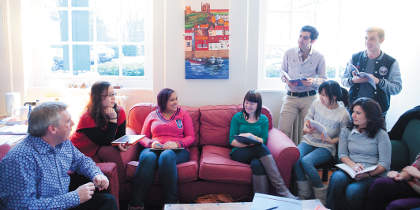
January 31, 2004, by Teaching at Nottingham
How “small” is a “small group”?
 Michael Humphreys:”I don’t think there is a critical size for a small group. We have tutorials with 20 to 25 per tutorial but I don’t see that as a small group.
Michael Humphreys:”I don’t think there is a critical size for a small group. We have tutorials with 20 to 25 per tutorial but I don’t see that as a small group.
“For me a group of between 4 and 10 is about right for small group teaching, depending on the nature of the task.”
 Ken Mellits: “My small group learning is actually student-led. It’s student-based learning so there are no lectures as such. For me the critical point was 5 students (I reduced group size from 8) based on the workload. With 8 students, some could get away with doing absolutely nothing; with 5 there’s no chance of that – everybody has to pull their weight.
Ken Mellits: “My small group learning is actually student-led. It’s student-based learning so there are no lectures as such. For me the critical point was 5 students (I reduced group size from 8) based on the workload. With 8 students, some could get away with doing absolutely nothing; with 5 there’s no chance of that – everybody has to pull their weight.
“So it ended up being the number that fitted the amount of work that there was. There was a very big difference having 8 groups of 5 students, rather than 5 groups of 8 students. The smaller groups were much, much better, as judged by the students’ assessment of their own work.”
 Pam Bishop: “It could be a group of fifty, but within that you could make ten groups of 5. As long as the framework for learning is very clear, you don’t have to be in control of that fifty. As long as each group has clear objectives, clear outlines of what’s expected to be achieved, how it’s going to be assessed at the end, then it’s manageable, and the group has to take some responsibility.
Pam Bishop: “It could be a group of fifty, but within that you could make ten groups of 5. As long as the framework for learning is very clear, you don’t have to be in control of that fifty. As long as each group has clear objectives, clear outlines of what’s expected to be achieved, how it’s going to be assessed at the end, then it’s manageable, and the group has to take some responsibility.
“It’s not something you’d do on the first day with a new group, but if you’re with a group over a whole semester, that ‘s certainly something you could be moving towards.”
These are Extracts from a panel discussion on small group teaching at the January 2004 PGCHE Introductory Event. Produced January 2004.
Prof Michael Humphreys,
Nottingham University Business School
Dr Ken Mellits,
Lecturer, Faculty of Science
School of Biosciences
Dr Pam Bishop (rtd.),
School of Education
No comments yet, fill out a comment to be the first

Leave a Reply